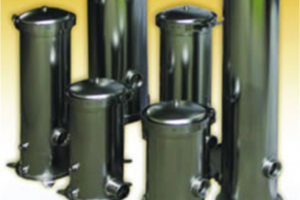Reverse Osmosis System
A reverse osmosis water purification unit (RO) is a portable, self-contained water treatment plant.
Designed for Human services use, it can provide potable water from nearly any water source.
work of detail RO plant
Reverse osmosis (RO) is a water purification technology that uses a semi permeable membrane to remove larger particles from drinking water. In reverse osmosis, an applied pressure is used to overcome osmotic pressure, a colligative property, that is driven by chemical potential, a thermo dynamic parameter. Reverse osmosis can remove many types of molecules and ions from solutions, including bacteria, and is used in both industrial processes and the production of potable water. The result is that the solute is retained on the pressurized side of the membrane and the pure solvent is allowed to pass to the other side. To be “selective”, this membrane should not allow large molecules or ions through the pores (holes), but should allow smaller components of the solution (such as the solvent) to pass freely. In the normal osmosis process, the solvent naturally moves from an area of high solute concentration (high water potential), through a membrane, to an area of low solute concentration (low water potential). The movement of a pure solvent is driven to reduce the free energy of the system by equalizing solute concentrations on each side of a membrane, generating osmotic pressure. Applying an external pressure to reverse the natural flow of pure solvent, thus, is reverse osmosis. The process is similar to other membrane technology applications. However, key differences are found between reverse osmosis and filtration. The predominant removal mechanism in membrane filtration is straining, or size exclusion, so the process can theoretically achieve perfect exclusion of particles regardless of operational parameters such as in fluent pressure and concentration. Moreover, reverse osmosis involves a diffusive mechanism, so that separation efficiency is dependent on solute concentration, pressure, and water flux rate.[1] Reverse osmosis is most commonly known for its use in drinking water purification from seawater, removing the salt and other effluent materials from the water molecules.
01 MICRON ACTIVATED CARBON HEAVY DUTY
When the water is passed through ULTRA PURE PAKISTAN Granular Activated Carbon (G.A.C) this Stage removes All organic chemicals, chlorine ammonia insecticides germicides herbicides pesticides down to 99% with this process order and bad taste of water are totally alimented and what you get is crystal clean pure drinking water.
ULTRA VOILET WITH CONTROL PANEL BOX
Ultra violet is Used in the Stage for Sterilization. Cristal Clear Water Passes through Ultraviolet light in a Reflected action this is accomplished by scrambling DNA structure of micro organisms which renders them Sterile ultra violet is regarded as world’s simplest and most practical means of destroying pathogenic micro-Organisms.
Key Health Advantage
Many years ago I drank reverse osmosis water almost exclusively, believing that it was the best drinking water. However, since then I have discovered (through personal experience and research) that the health disadvantages outweigh the advantages.
The main health advantage R.O. water has over tap water is that an R.O. system removes some unhealthy contaminants.
A good R.O. system can remove contaminants such as arsenic, nitrates, sodium, copper and lead, some organic chemicals, and the municipal additive fluoride.






